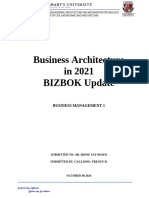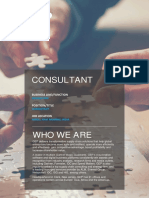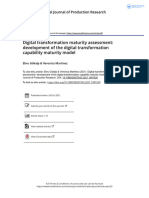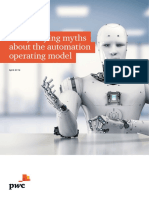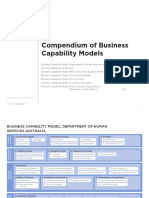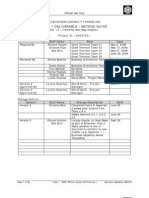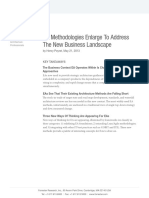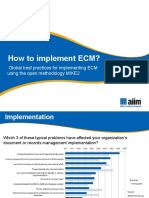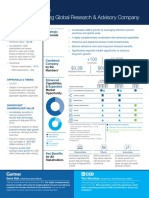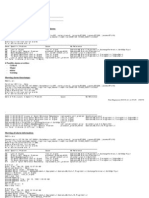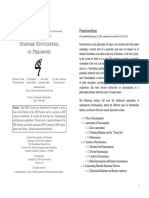0 ratings0% found this document useful (0 votes)
61 viewsFRAMEWORK For Digital Transformation
FRAMEWORK For Digital Transformation
Uploaded by
sushantnit_120841767The document outlines a framework for digital transformation consisting of 10 key elements: assessment and awareness, strategy development, organization and culture, technology and infrastructure, implementation and scaling, customer and stakeholder engagement, data and analytics, digital products and services development, security and compliance, and continuous improvement and innovation.
Copyright:
© All Rights Reserved
Available Formats
Download as DOCX, PDF, TXT or read online from Scribd
FRAMEWORK For Digital Transformation
FRAMEWORK For Digital Transformation
Uploaded by
sushantnit_1208417670 ratings0% found this document useful (0 votes)
61 views2 pagesThe document outlines a framework for digital transformation consisting of 10 key elements: assessment and awareness, strategy development, organization and culture, technology and infrastructure, implementation and scaling, customer and stakeholder engagement, data and analytics, digital products and services development, security and compliance, and continuous improvement and innovation.
Original Description:
FRAMEWORK for Digital Transformation
Original Title
FRAMEWORK for Digital Transformation
Copyright
© © All Rights Reserved
Available Formats
DOCX, PDF, TXT or read online from Scribd
Share this document
Did you find this document useful?
Is this content inappropriate?
The document outlines a framework for digital transformation consisting of 10 key elements: assessment and awareness, strategy development, organization and culture, technology and infrastructure, implementation and scaling, customer and stakeholder engagement, data and analytics, digital products and services development, security and compliance, and continuous improvement and innovation.
Copyright:
© All Rights Reserved
Available Formats
Download as DOCX, PDF, TXT or read online from Scribd
Download as docx, pdf, or txt
0 ratings0% found this document useful (0 votes)
61 views2 pagesFRAMEWORK For Digital Transformation
FRAMEWORK For Digital Transformation
Uploaded by
sushantnit_120841767The document outlines a framework for digital transformation consisting of 10 key elements: assessment and awareness, strategy development, organization and culture, technology and infrastructure, implementation and scaling, customer and stakeholder engagement, data and analytics, digital products and services development, security and compliance, and continuous improvement and innovation.
Copyright:
© All Rights Reserved
Available Formats
Download as DOCX, PDF, TXT or read online from Scribd
Download as docx, pdf, or txt
You are on page 1of 2
FRAMEWORK for Digital Transformation
A framework for digital transformation can provide a structured approach to guide
organizations through the complex process of integrating digital technologies into
their business models, processes, products, and culture. Here's a comprehensive
framework that encompasses key elements and steps organizations can follow to
ensure a successful digital transformation:
1. Assessment and Awareness
Digital Maturity Assessment: Evaluate the current state of digital technology
within the organization.
Awareness and Vision Setting: Develop a clear understanding of digital
possibilities and define a vision for how digital can transform the organization.
2. Strategy Development
Digital Strategy Formulation: Align digital transformation objectives with
the overall business strategy, identifying how digital initiatives can drive
business goals.
Roadmap Planning: Create a detailed action plan with milestones, timelines,
and KPIs to measure progress.
3. Organization and Culture
Leadership and Governance: Establish a governance structure to oversee the
transformation, involving leadership commitment and cross-functional teams.
Cultural Change Management: Foster a digital culture that encourages
innovation, agility, and continuous learning.
4. Technology and Infrastructure
Technology Assessment: Identify the digital technologies that can support
the transformation, such as cloud computing, AI, data analytics, and IoT.
Infrastructure Modernization: Upgrade or replace legacy systems to support
new digital technologies and ensure interoperability.
5. Implementation and Scaling
Pilot Projects: Start with small-scale projects to test concepts and learn from
the outcomes.
Scaling Up: Based on pilot project successes, scale up digital initiatives across
the organization.
6. Customer and Stakeholder Engagement
Customer Experience Transformation: Use digital channels and
technologies to enhance customer experiences.
Stakeholder Communication: Engage with internal and external stakeholders
through the transformation process to ensure alignment and support.
7. Data and Analytics
Data Strategy: Develop a strategy for collecting, managing, and analyzing
data to drive decision-making.
Leveraging Analytics: Use analytics and business intelligence tools to gain
insights and inform strategy.
8. Digital Products and Services Development
Innovation in Products/Services: Leverage digital technologies to create
new or improved products and services.
Agile Development: Adopt agile methodologies for rapid development and
continuous improvement of digital offerings.
9. Security and Compliance
Cybersecurity Framework: Implement robust cybersecurity measures to
protect digital assets and data.
Regulatory Compliance: Ensure all digital initiatives comply with relevant
laws and regulations.
10. Continuous Improvement and Innovation
Feedback Loops: Establish mechanisms for collecting feedback from
customers, employees, and other stakeholders.
Ongoing Innovation: Continuously explore new technologies and business
models to stay ahead in a digitally transforming world.
You might also like
- Business Architecture Updated Bizbok October07Document4 pagesBusiness Architecture Updated Bizbok October07CACLIONG FRENZY B.No ratings yet
- Tia CompleteDocument373 pagesTia CompleteportucasbasNo ratings yet
- Sustainability Business Capabilities ModelDocument8 pagesSustainability Business Capabilities ModelCapability ModelNo ratings yet
- EY Digital Supply Chain Its All About That Data Final 2Document16 pagesEY Digital Supply Chain Its All About That Data Final 2udayNo ratings yet
- Digital Transformation BCG PDFDocument1 pageDigital Transformation BCG PDFMinhDuongNo ratings yet
- Accelerating Digital To Build The 'Bionic Company' Framework and Case StudyDocument27 pagesAccelerating Digital To Build The 'Bionic Company' Framework and Case StudyFrank NyamzNo ratings yet
- Parted Magic PxeDocument3 pagesParted Magic Pxesn_moorthyNo ratings yet
- GARTNER 00784318-4-Ea-Practices-That-Add-Value-To-Ai-InitiativesDocument13 pagesGARTNER 00784318-4-Ea-Practices-That-Add-Value-To-Ai-Initiativesstephane_smetsNo ratings yet
- Business Transformation at Stickley FurnitureDocument11 pagesBusiness Transformation at Stickley FurnitureReyte on Publishing A. Johnson100% (1)
- Digital Maturity Is Paying Off: by Michael Grebe, Michael Rüßmann, Michael Leyh, and Marc Roman FrankeDocument7 pagesDigital Maturity Is Paying Off: by Michael Grebe, Michael Rüßmann, Michael Leyh, and Marc Roman FrankeRichard PubNo ratings yet
- Adaptive Data GovernanceDocument16 pagesAdaptive Data Governancebharath10041982No ratings yet
- Digitalization Maturity Report 2017Document45 pagesDigitalization Maturity Report 2017Aman VarshneyNo ratings yet
- HFS HZ 2023 Oct Generative Enterprise Services 2023 3Document82 pagesHFS HZ 2023 Oct Generative Enterprise Services 2023 3Vidhya Charan P100% (1)
- The Relationship Between Information Technology and MarketingDocument7 pagesThe Relationship Between Information Technology and MarketingAmber SahuNo ratings yet
- Presentations - Day 3 & 4-Capability Maturity Model Integration (CMMI)Document46 pagesPresentations - Day 3 & 4-Capability Maturity Model Integration (CMMI)Benjamin FamiliNo ratings yet
- Top Priorities For It: Leadership Vision For 2021: Cios and Heads of ItDocument8 pagesTop Priorities For It: Leadership Vision For 2021: Cios and Heads of ItThe Zensitive GroupNo ratings yet
- Digital Maturity: Definition and Model: Aslanova I.V. Kulichkina A.IDocument7 pagesDigital Maturity: Definition and Model: Aslanova I.V. Kulichkina A.ITimur MatkassimovNo ratings yet
- Data and Analytics Governance RoadmapDocument13 pagesData and Analytics Governance RoadmapNazri NawiNo ratings yet
- Top 10 Strategic Technology 327329Document34 pagesTop 10 Strategic Technology 327329benozaman100% (1)
- Altimeter 6 Stages of DTDocument55 pagesAltimeter 6 Stages of DTrkponrajNo ratings yet
- Four - Scenarios - For - How - Cios Can Clarify or Deduce Their Business StrategiesDocument11 pagesFour - Scenarios - For - How - Cios Can Clarify or Deduce Their Business StrategiesJOSENo ratings yet
- Board Presentation - OX SlidesDocument5 pagesBoard Presentation - OX SlidesCandice H.100% (1)
- DI Flexible OrganizationsDocument12 pagesDI Flexible OrganizationsHilvadiazNo ratings yet
- The 9 Traits of Future-Ready CompaniesDocument11 pagesThe 9 Traits of Future-Ready CompaniesVasanth RaghavanNo ratings yet
- Global Digital Operations Study - Digital ChampionsDocument64 pagesGlobal Digital Operations Study - Digital ChampionsVictor HoNo ratings yet
- Accenture-Analytics-Operating-Model Ref PDFDocument16 pagesAccenture-Analytics-Operating-Model Ref PDFDeepak SharmaNo ratings yet
- Governance and COE: Key Components of A Successful Business TransformationDocument39 pagesGovernance and COE: Key Components of A Successful Business TransformationGreg IkeNo ratings yet
- Future of EA - 269850Document14 pagesFuture of EA - 269850Renato Cardoso BottoNo ratings yet
- Gep JD PDFDocument2 pagesGep JD PDFAdarsh BansalNo ratings yet
- Analytics in Business Support FunctionsDocument99 pagesAnalytics in Business Support FunctionsHarsh RanaNo ratings yet
- DT Maturity Assessment 2021Document22 pagesDT Maturity Assessment 2021Sarah BayachNo ratings yet
- Exhibit 3 - New York State Ies Target Operating ModelDocument63 pagesExhibit 3 - New York State Ies Target Operating ModelRavinder KNo ratings yet
- Demystifying Myths About The Automation Operating ModelDocument8 pagesDemystifying Myths About The Automation Operating ModelKNo ratings yet
- 2024 Cio Agenda EbookDocument15 pages2024 Cio Agenda Ebookyuri.rodriguesNo ratings yet
- How IT Is Reinventing Itself As A Strategic Business PartnerDocument3 pagesHow IT Is Reinventing Itself As A Strategic Business PartnerJoana ReisNo ratings yet
- Gene AIDocument13 pagesGene AIGeremewNo ratings yet
- The Forrester Wave™ - Enterprise Data Catalogs For DataOps, Q2 2022Document12 pagesThe Forrester Wave™ - Enterprise Data Catalogs For DataOps, Q2 2022Yann VincentNo ratings yet
- Gartner Critical Capabilities For Strategic Enterprise Performance Management SolutionsDocument12 pagesGartner Critical Capabilities For Strategic Enterprise Performance Management Solutionsanon_550440081100% (1)
- Effect of Technology Strategy On Organizational PerformanceDocument18 pagesEffect of Technology Strategy On Organizational PerformanceSuriani SukriNo ratings yet
- Bimodal - Raising Everyone's Game For Digital BusinessDocument32 pagesBimodal - Raising Everyone's Game For Digital BusinessMiguel SanchezNo ratings yet
- Bus CapabilitiesDocument24 pagesBus CapabilitiesThiago Emílio Menezes SantosNo ratings yet
- Strategic Agility in A Changing World 20190418Document12 pagesStrategic Agility in A Changing World 20190418Naveen Niraj100% (1)
- The Organisation Capability Maturity Framework (Org-CMF) StructureDocument3 pagesThe Organisation Capability Maturity Framework (Org-CMF) Structurekarthik sNo ratings yet
- Task 1 - BCM Method - Guide V5e FinalDocument86 pagesTask 1 - BCM Method - Guide V5e Finalilumezianu100% (1)
- EA Methodologies Enlarge To Address The New Business LandscapeDocument13 pagesEA Methodologies Enlarge To Address The New Business LandscapeImmanuel GiuleaNo ratings yet
- NDA Maturity Assessment WorksheetDocument31 pagesNDA Maturity Assessment Worksheetholamundo123No ratings yet
- Presentation Deck HereDocument37 pagesPresentation Deck Hereghada.guirguisNo ratings yet
- How To Implement EcmDocument54 pagesHow To Implement Ecmsanchu1981No ratings yet
- CEB Architecture High Impact CapabilityDocument12 pagesCEB Architecture High Impact CapabilityCody LeeNo ratings yet
- How To Become Tech Forward A Technology Transformation Approach That WorksDocument7 pagesHow To Become Tech Forward A Technology Transformation Approach That WorksPatricia GarciaNo ratings yet
- Use Adaptive Sourcing To Drive Double Digit Cost Optimization of It and Business ProcessesDocument14 pagesUse Adaptive Sourcing To Drive Double Digit Cost Optimization of It and Business ProcessesmwhaliNo ratings yet
- TDWI Checklist Report Halper Snowflake Generative AI WebDocument10 pagesTDWI Checklist Report Halper Snowflake Generative AI Webjrendon_2009No ratings yet
- Digital Transformation StrategyDocument30 pagesDigital Transformation StrategySteve LeeNo ratings yet
- Balance ScorecardDocument12 pagesBalance ScorecardAlejandro LSNo ratings yet
- Creating The Leading Global Research & Advisory Company: StrategicDocument2 pagesCreating The Leading Global Research & Advisory Company: Strategicanuj.arora02001021100% (1)
- SOA-Forrester SOA Enterprise Architecture Best PracticesDocument7 pagesSOA-Forrester SOA Enterprise Architecture Best PracticesKalpan Raval100% (1)
- Human ResourcesDocument12 pagesHuman ResourcesulluNo ratings yet
- Accenture Signals of Change Business Futures 2021 Executive SummaryDocument41 pagesAccenture Signals of Change Business Futures 2021 Executive Summaryjuan pereztasNo ratings yet
- Enterprise Architecture Metrics A Clear and Concise ReferenceFrom EverandEnterprise Architecture Metrics A Clear and Concise ReferenceNo ratings yet
- Neurocapitalism. Technological Mediation and Vanishing LinesDocument253 pagesNeurocapitalism. Technological Mediation and Vanishing LinesMinor Compositions100% (8)
- Introduction To Cmos Vlsi Design: Nonideal TransistorsDocument30 pagesIntroduction To Cmos Vlsi Design: Nonideal TransistorsSumanth VarmaNo ratings yet
- D5 M2 CadastralDocument8 pagesD5 M2 CadastralAbdulwarith AWALNo ratings yet
- REVIGO 2017 Original Colours of Van Gogh's PaintingsDocument6 pagesREVIGO 2017 Original Colours of Van Gogh's Paintingssdrtfg100% (1)
- Basic Shortcut KeysDocument4 pagesBasic Shortcut KeysmalawsatejNo ratings yet
- HeuristicsDocument14 pagesHeuristicsazarNo ratings yet
- Schedule BsbaDocument7 pagesSchedule BsbaLYCEUM OF WESTERN LUZON -ZAMBALES INCNo ratings yet
- Un Român, Aeronaut În Polonia, La Începutul Secolului Al Xix - Lea: Iordache CuparencuDocument26 pagesUn Român, Aeronaut În Polonia, La Începutul Secolului Al Xix - Lea: Iordache CuparencuCodrin Codrin100% (1)
- Moshell Al CommandDocument4 pagesMoshell Al CommandaligokhanNo ratings yet
- Lab Sheet - Specific GravityDocument5 pagesLab Sheet - Specific GravityLuqman YusofNo ratings yet
- A-File Description - SpanishDocument23 pagesA-File Description - Spanishmayra almaNo ratings yet
- Binary Code and Error DetectionDocument109 pagesBinary Code and Error Detectionchvinayaka5895No ratings yet
- Admin, Journal Manager, Hal 1-14Document14 pagesAdmin, Journal Manager, Hal 1-14CHANNEL KUNo ratings yet
- Deckel-Manual S0EDocument12 pagesDeckel-Manual S0ECronopio Cronopiando100% (2)
- GL Name Subcatdesc Asin EAN Description Qty Unit RetailDocument49 pagesGL Name Subcatdesc Asin EAN Description Qty Unit RetailAnton ZhyrkovNo ratings yet
- 10-What Is Psychological CriticismDocument3 pages10-What Is Psychological Criticismsaadi mziriNo ratings yet
- March15 CatchupDocument16 pagesMarch15 Catchupkrysteen.gavinaNo ratings yet
- CM20170915 60253 59723 PDFDocument2 pagesCM20170915 60253 59723 PDFvarun m100% (1)
- Educ 5312-Research Paper Abdulkadir CiplakDocument7 pagesEduc 5312-Research Paper Abdulkadir Ciplakapi-322522017No ratings yet
- Faraday 59th Minute Correction ProtocolDocument2 pagesFaraday 59th Minute Correction ProtocolAceNo ratings yet
- FunctionalismDocument33 pagesFunctionalismvsuboticNo ratings yet
- Liner HangersDocument38 pagesLiner HangerssauloeganaNo ratings yet
- Walt Investment CaseDocument4 pagesWalt Investment CaseCr CryptoNo ratings yet
- Jovees Herbals HTC On Moj-Terms and ConditionsDocument4 pagesJovees Herbals HTC On Moj-Terms and Conditionspiyoga5540No ratings yet
- Lac Session - EspDocument2 pagesLac Session - EspJevan Hope Baltazar100% (1)
- Report On Bamboo As A Building MaterialDocument33 pagesReport On Bamboo As A Building MaterialBhaskar Barman100% (1)
- HLK PM03Document13 pagesHLK PM03RnDES1 CMLNo ratings yet
- Module 3: Morphology Inflectional and Derivation MorphologyDocument17 pagesModule 3: Morphology Inflectional and Derivation Morphologyshuchis785No ratings yet
